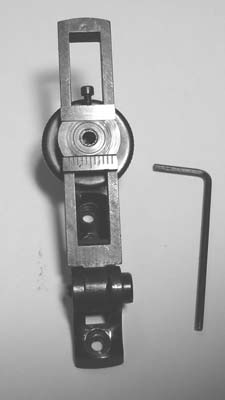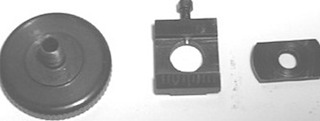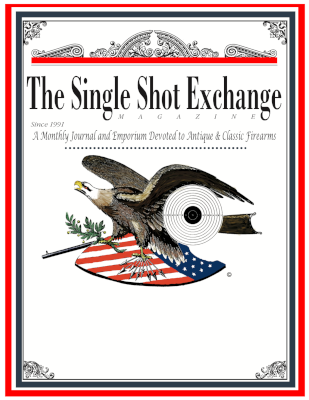Sight Solution
by Brett Boyd
A couple of weeks ago, I received an interesting e-mail from one of our subscribers. Hugh had purchased one of the excellent reproduction Stevens #102 vernier tang sights sold by Jeff’s Outfitters. These are wonderful sights and I have used a bunch of them on Favorites, Model 44s and mod 44-1/2s. For those of you unfamiliar with this sight, it incorporates both windage and elevation in a “slider” arrangement which is locked in position by tightening the eyecup. A simple and effective arrangement in every regard. Hugh said that he needed a way to make elevation adjustments without disturbing the windage. This is really not possible with the sight as originally designed. I had always mounted these sights on .22 caliber rifles and sighted them in at a specific range and just locked them down.
position by tightening the eyecup. A simple and effective arrangement in every regard. Hugh said that he needed a way to make elevation adjustments without disturbing the windage. This is really not possible with the sight as originally designed. I had always mounted these sights on .22 caliber rifles and sighted them in at a specific range and just locked them down.
Apparently Hugh was using the sight on a centerfire rifle and making adjustments for the longer ranges which would then require both windage and elevation adjustments at each range. This would be a real nuisance. I looked at one of these sights on my Stevens rifle and told Hugh to send me his sight; I had an idea to fix this problem.
My solution was to drill and tap the slider bar on the sight in a position directly above the windage bar and insert a small screw that would lock the windage bar in place as the elevation adjustments were made. It’s a simple fix but required some very careful machining to accomplish. You can’t do this with your Black and Decker hand drill! After disassembling the sight and removing the slider bar I clamped the  slider bar, with a piece of mild steel in the windage slot, and located the center of the bar. It’s only .150 ” wide and as I planned to use a 2-56 socket head cap screw this would only leave about .040 ” per side. The mild steel spacer in the windage slot is to make sure that the drilling and tapping is straight; you can’t drill into a piece of steel to a void and expect the little .070 drill to stay straight.
slider bar, with a piece of mild steel in the windage slot, and located the center of the bar. It’s only .150 ” wide and as I planned to use a 2-56 socket head cap screw this would only leave about .040 ” per side. The mild steel spacer in the windage slot is to make sure that the drilling and tapping is straight; you can’t drill into a piece of steel to a void and expect the little .070 drill to stay straight.
This having been done, the hole was precisely located and carefully drilled and tapped 2-56. The resulting tapped hole overlaps the windage slot by about .030, which is enough to get a good bite on the windage slider. Now all you have to do is sight in the rifle and lock the windage bar by tightening the 2-56 screw with a 5/64th inch Allen key. Now when you loosen the eyecup to make elevation changes the windage bar is locked in position. It may not be the best way to do this but it looks and works good.
Thought I’d pass this along to you gun cranks. Oh, yes, one other thing I need to mention, I didn’t have any 3/8″ 2-56 socket head cap screws and had to buy a box of 100, so if any of you guys try this fix, I’ll send you a couple for the price of a stamp!
Upon receipt of the fixed sight, Hugh responded thusly: “Thank you! The sight came this afternoon. I’m just back from the range. It works great! The frustration is over. I can’t tell you how much I appreciate your doing this for me. There’s no way I could have drilled/tapped that fine little hole! It really enhances the enjoyment of the rifle to be able to use a tang sight. I really owe you one.~



